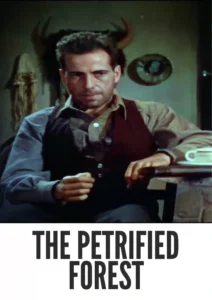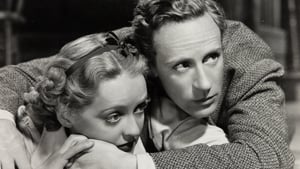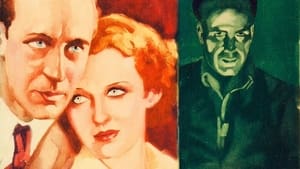Video Sources 0 Views
- Watch trailer
- The Petrified Forest


Synopsis
Table of Contents
ToggleLove, Gangsters, and Existential Dread: The Petrified Forest (1936) in Vibrant Color

Step into the sun-baked world of The Petrified Forest, a thought-provoking drama from 1936, now beautifully colorized for a visually stunning experience. Featuring Humphrey Bogart and Leslie Howard, this film, sometimes referred to as Escape in the Desert, delivers a unique blend of romance, crime, and existentialism set against the backdrop of the Arizona desert. Perfect for fans of classic cinema and those seeking a film with depth and style, this HD download brings a timeless story to life with vivid color and clarity.
The Petrified Forest Storyline: Crossroads in the Desert
The Petrified Forest centers on Alan Squier (Leslie Howard), a disillusioned intellectual drifting through the American Southwest. He stumbles upon a roadside diner in the Arizona desert, where he meets Gabrielle Maple (Bette Davis), a young woman dreaming of escaping her small-town life to become an artist in France.Their lives are disrupted by the arrival of Duke Mantee (Humphrey Bogart), a notorious gangster on the run with his crew. As the group is held hostage, their lives intertwine, leading to intense confrontations and profound reflections on life, death, and the American Dream. Alan, feeling life has passed him by, sees an opportunity for one grand gesture. The Petrified Forest explores themes of disillusionment, hope, and the clash between civilization and barbarism.
Movie Cast
The film showcases powerful performances from its talented cast:
- Leslie Howard as Alan Squier
- Bette Davis as Gabrielle Maple
- Humphrey Bogart as Duke Mantee
- Genevieve Tobin as Mrs. Chisholm
- Dick Foran as Boze Hertzlinger
Movie Genre
The Petrified Forest masterfully blends elements of drama, film noir, and crime thriller, creating a unique and unforgettable cinematic experience. Its exploration of complex themes and compelling characters sets it apart as a standout film of the era.
Historical Context: Social Commentary and the Pre-War Era
Released in 1936, The Petrified Forest reflects the social and economic anxieties of the Great Depression era, offering a critical commentary on American society and the disillusionment of the time. The film’s success helped solidify Humphrey Bogart’s status as a major Hollywood star. As a product of its time, The Petrified Forest offers valuable insights into the cultural and political landscape of pre-World War II America.
Colorization Details
This colorized version of The Petrified Forest has been meticulously restored, using modern digital techniques to enhance the visual appeal while preserving the film’s original atmosphere. The colorization process involved careful analysis of the grayscale tones in the original black and white footage, assigning appropriate colors to each scene. This painstaking process brings new life to the characters and settings, making the story even more engaging for modern audiences.
Technical Details
- Director: Archie Mayo
- Screenplay: Charles Kenyon, Delmer Daves
- Based on: the play by Robert E. Sherwood
- Cinematography: Sol Polito
- Edited by: Owen Marks
- Production Company: Warner Bros.
- Distributed by: Warner Bros.
- Runtime: 82 minutes
Technical Specifications
- Download Format: MP4
- Resolution: HD (1080p)
- Compatibility: Compatible with most devices, including smartphones, tablets, computers, and smart TVs.
Reviews and Critical Reception
The Petrified Forest (1936) is celebrated for its sharp dialogue, compelling performances, and thought-provoking themes. The film is particularly noted for Humphrey Bogart’s breakout role as Duke Mantee, which helped establish his iconic tough-guy persona. As a timeless classic, The Petrified Forest continues to resonate with audiences today.
FAQs
- Q: What is The Petrified Forest about?
- A: The Petrified Forest tells the story of a disillusioned intellectual who encounters a gangster and a young woman dreaming of escape in a roadside diner.
- Q: Is The Petrified Forest (1936) a well-regarded film?
- A: Yes, The Petrified Forest is a highly regarded classic, known for its performances and social commentary.
- Q: Is this version of The Petrified Forest colorized?
- A: Yes, this version has been professionally colorized to enhance the viewing experience.
- Q: What makes The Petrified Forest significant in film history?
- A: The Petrified Forest is significant for launching Humphrey Bogart’s career and for its insightful portrayal of American society during the Great Depression.
- Q: What is the download format?
- A: The download format is MP4, which is compatible with most devices.
- Q: What resolution is the download?
- A: The resolution is HD (1080p), providing a high-quality viewing experience.
Download Now in HD!
Watch The Petrified Forest Today!














